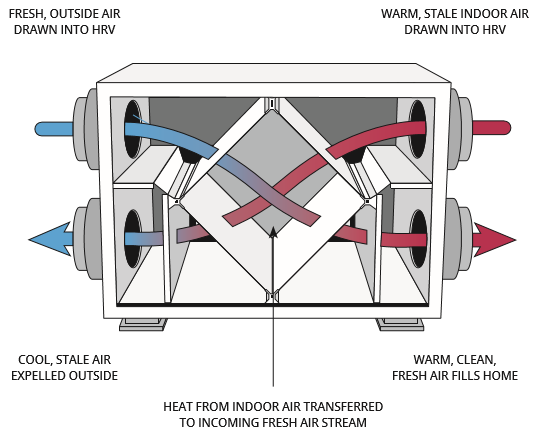The All-Inclusive Overview to the Uses of Heat Recovery Ventilation in Modern Structures
Heat Recovery Ventilation (HRV) systems stand for a considerable advancement in developing modern technology (HRV Heat Recovery Ventilation). They supply a method for exchanging stale indoor air with fresh exterior air while lessening energy loss. This technique not just enhances indoor air top quality but likewise contributes to power efficiency in both household and industrial buildings. Understanding the numerous applications and advantages of HRV can reveal its vital duty in contemporary design and sustainability efforts. The effects of this technology are worth exploring additionally
Comprehending Heat Recovery Ventilation Equipments

Several modern-day buildings focus on power effectiveness, understanding heat recovery ventilation (HRV) systems is essential for optimizing indoor air quality and reducing energy usage. HRV systems function by transferring warm from stagnant indoor air to inbound fresh air, successfully keeping comfy interior temperatures while minimizing power loss. These systems contain a warmth exchanger, fans, and ductwork that assist in the blood circulation of air. Throughout wintertime, HRV units capture and reuse warm from the outgoing air, while in summer, they can help cool down incoming air. By constantly trading air, HRV systems additionally lower humidity and the concentration of indoor contaminants. Proper setup and maintenance of HRV systems are important for their performance and efficiency in boosting general structure efficiency and convenience.
Benefits of Heat Recovery Ventilation
Heat recovery ventilation systems supply numerous advantages that enhance both energy performance and indoor air top quality in modern-day structures. By capturing and reusing energy from exhaust air, these systems considerably minimize cooling and heating expenses, leading to reduced energy intake. Furthermore, they keep a consistent circulation of fresh outdoor air, decreasing the threat of interior air pollutants and irritants. This constant exchange assists control humidity levels, avoiding mold and mildew development and making certain a much healthier living atmosphere. In addition, HRV systems contribute to sustainability goals by decreasing general carbon footprints. Their ability to optimize air flow without sacrificing thermal convenience makes them a beneficial enhancement to contemporary structure style, promoting both economic and eco-friendly benefits.
Applications of HRV in Residential Buildings
As property owners increasingly prioritize power effectiveness and indoor air high quality, the applications of warmth recovery air flow (HRV) systems in property buildings have actually ended up being extra widespread. HRV systems are especially valuable in snugly secured homes, where preserving fresh air flow is crucial for stopping moisture buildup and indoor pollutants. They efficiently move warm from outgoing stale air to incoming fresh air, reducing power prices related to cooling and heating. In addition, helpful resources HRVs can improve comfort levels by controling humidity and temperature. They are also adaptable for various property designs, consisting of single-family homes and multi-unit structures. On the whole, incorporating HRV systems sustains lasting living techniques while guaranteeing a much healthier indoor setting for owners.
HRV in Business and Industrial Setups
In commercial and commercial setups, the execution of warmth healing air flow (HRV) systems has become progressively important for maximizing power performance and keeping air top quality. These systems successfully transfer warm from exhaust air to incoming fresh air, decreasing the demand for added heating or air conditioning. This not only decreases energy expenses however likewise adds to sustainability efforts. Industries such as manufacturing, warehousing, and office complex benefit significantly from HRV systems, as they aid regulate temperature level and moisture degrees, making certain a comfy and efficient setting. HRV systems aid in removing contaminants and excess moisture, improving indoor air top quality. As guidelines around air quality end up being stricter, the fostering of HRV technology is most likely to grow, making it an important part of modern-day business and commercial infrastructure.
Future Trends in Heat Recovery Ventilation Modern Technology

Frequently Asked Concerns
Just How Does Heat Recovery Ventilation Impact Indoor Air Top Quality?
Heat YOURURL.com recovery ventilation significantly boosts indoor air quality by constantly exchanging stale interior air with fresh outdoor air while recovering power. This process lowers pollutants, preserves excellent humidity degrees, and guarantees a much healthier environment for owners.
Can HRV Systems Be Installed in Existing Structures?
HRV systems can certainly be installed in existing structures. Retrofitting might require modifications to ductwork and ventilation formats, yet it significantly improves power performance and interior air high quality, making it a feasible option for older structures.
What Upkeep Is Required for HRV Solutions?

Exist Specific Climates Where HRV Is Much More Reliable?
Heat recovery ventilation systems are particularly reliable in environments with considerable temperature distinctions between periods. These systems maximize energy performance by recouping heat from exhaust air, making them perfect for both chilly and moderately cozy atmospheres.
Just How Do HRV Systems Affect Power Bills?
